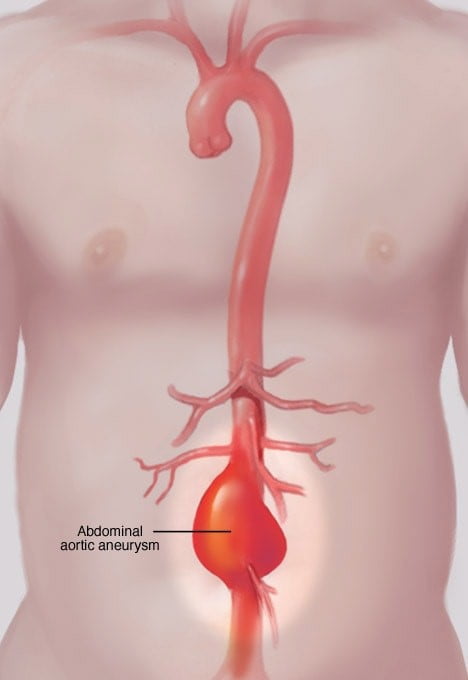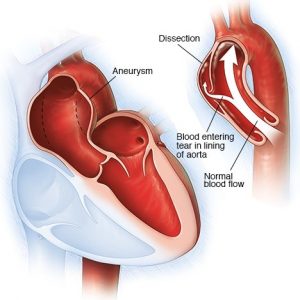Make an Appointment Now
info@macitbitargil.com
Acıbadem Hospitals
Make an Appointment Now
info@macitbitargil.com
Acıbadem Hospitals

The aorta is the largest blood vessel in the body. The aorta, which comes out of the left ventricle of the heart, ensures that the oxygenated clean blood in the lungs is pumped to the whole body through the heart. After the aorta leaves the heart, it first reaches the coronary artery, the vessel that feeds the heart. Continuing upward, the aorta reaches the brain and arms. Then it curves downwards, bifurcates in the groin area and descends to the legs.
The aorta has 5 different sections: ascending aorta, descending aorta, transverse aorta, thoracic aorta and abdominal aorta. The ascending aorta is the section after it leaves the heart. The transverse aorta is the region where the cerebral vessels arise, the descending aorta is the part descending from the dorsal region, the thoracic aorta is the part in the thoracic cavity, and the abdominal aorta is the part in the abdomen.
The diameter of the part where the aorta, which is the main vessel that distributes blood to the body, exits from the heart is approximately 2.5 cm, and an average of 5 liters of blood per minute passes through the aorta.
An aortic aneurysm is defined as a 50% larger enlargement of the vessel diameter than normal as a result of a kind of ballooning in the aortic artery. Since aortic aneurysm is a condition that occurs in areas where the vessel wall is weak, it is possible to occur in any region of the aortic vessel.
Although the aneurysm grows in size over time and does not show any symptoms at the initial stage, various symptoms may occur with the enlargement of the aneurysm.
There are three types of aneurysms based on their location in the aorta: thoracic, abdominal, and thoracoabdominal.
Thoracic Aortic Aneurysm: An aortic aneurysm that develops in the chest is called a thoracic aortic aneurysm. Many people with thoracic aortic aneurysms have no symptoms. Thoracic aortic aneurysms are also classified according to their location in the chest.
Abdominal Aortic Aneurysm: An aortic aneurysm that develops under the chest is called an abdominal aortic aneurysm. These are more common than thoracic aortic aneurysms and are more common in men than women. Small abdominal aortic aneurysms can become quite large over time without causing symptoms. This type of slow-growing aneurysm rarely ruptures. A rapidly expanding abdominal aortic aneurysm is more likely to cause symptoms such as sudden abdominal or back pain and is at risk of rupture.
Thoracoabdominal Aortic Aneurysm: Thoracoabdominal aortic aneurysm extends from the thoracic portion to the abdominal portions of the aorta. It rarely causes symptoms, but in some cases it can expand enough to cause a rupture. This type of aneurysm can be more complicated to repair than other types, as it runs through parts of the aorta that connects to the liver, kidneys, intestines, and arteries that supply blood to the spine.
Aortic aneurysm, which occurs with the expansion of the vessel in the form of bubbles in areas where the aortic vessel is weak, usually does not show any symptoms, although it can grow over time. Rarely, pressure on the breathing and/or esophagus may occur.
If the aortic aneurysm grows too large, the aorta may rupture. In this case, it is possible to be life-threatening and even cause sudden death.
An aortic aneurysm can also disrupt blood flow in the vessel, leading to clotting. In some cases, there is a risk that the blood clot may be caught in the blood stream and enter the body circulation. If a part of the clot blocks the blood flow in the arm, leg or foot areas, conditions such as numbness, chills, local pain, weakness, tingling and dizziness may occur.
If the vessels in vital organs such as the kidney and liver are blocked by a blood clot, deterioration in the functions of the organs may occur. If the blood clot from the aortic aneurysm gets stuck in the heart or brain vessels, very serious health problems such as stroke or heart attack may occur.
After an aortic aneurysm has formed, it may enlarge over time and is usually asymptomatic. Although it is mostly noticed during an examination for another disease or during routine health checks, it can cause symptoms in some cases.
Aortic aneurysm symptoms usually present as intermittent or persistent pain in the chest or abdomen. Difficulty in swallowing, back pain, or shortness of breath may occur in a thoracic aortic aneurysm.
Rupture of the aneurysm causes sudden and very severe pain. Emergency medical attention is required as the patient will lose consciousness in a short time and go into shock.

Aneurysm treatment is determined by the location of the aneurysm, its size, growth rate and whether it causes a complaint in the patient. Small aneurysms can be treated without treatment, while large aneurysms may require surgical intervention.
Beta-blocker types of drugs are prescribed for patients who are considered suitable for drug therapy. It is very important for the patient to quit smoking. Since intravascular pressure is very important in aneurysm, blood pressure should be kept under control.
If intervention is required, two different methods can be applied:
After the treatment of aortic aneurysm, the drugs prescribed by the doctor should be taken regularly. Adequate and quality sleep positively affects the healing process. During the early recovery period, it is necessary not to lie flat.
All content on the website is for informational purposes only. Consult your doctor for diagnosis and treatment methods.
2022 © All Rights reserved | Design & SEO & Development Simur Digital